
Wine Culture and Information since 2002 - Volume 23
 Wine Culture and Information since 2002 - Volume 23 |
|
Issue 245, December 2024 |
Contents |
|
|
Wine, Alcohol and Time Passing By |
|
As many know, my interest in wine is mainly of a technical nature, that is, I am mainly interested in technical, viticultural and enological topics, not least, indeed, more so, those related to organoleptic and sensorial qualities. Topics that – with equal passion and enthusiasm – also interest me in the other areas that are part of my professional and educational activities, among these, cooking, tea, coffee, cocoa and chocolate, beer and spirits, just to name the main ones. In each of these areas, sensorial tasting is evidently fundamental to increasing my knowledge, an exercise of essential importance when it is carried out, of course, with the rigor and purpose of study. A habit that turns out to be of primary importance, in this sense, is that of taking note of each tasting, not only of the specific qualities and deriving from the evaluation of the tasting, but also of the environmental and technical conditions existing during the evaluation. These notes, regardless of the way in which they are compiled – from writing in notebooks, sheets of paper, including the use of software applications – are essential for the creation of a database, very useful, not least, for revision and comparison purposes. No less important, for remembering. In my case, all my tasting notes, for all the areas and themes that concern me, have always been stored and organized using specific software that I have personally designed and developed. As for wine, the software that I have designed and use – a project started in 1995, still in development and evolution – is EnoExpert, an expert system capable of making organoleptic and production predictions on wines based on parameters that define, for example, territory, grapes, winemaking practices, climatic and environmental conditions. EnoExpert, moreover, has been designed for the management of tasting notes and, in this sense, I use it for the keeping of my personal tastings, now close to 85,000. Among the information that I keep and note for each wine tasted, there is also its alcohol content, specifically, the one declared by the producer on the label. Among the advantages – I would add, the beauty – of having at hand a important quantity of data, there is also that of being able to perform statistical analyses, which generate – very often – very interesting and significant results. Among these, for example, the use of grapes in the territories in the course of time: an interesting statistical analysis that often highlights the trend of certain fads and the development of denominations, as well as entire regions and countries. Another statistical study is that of the alcohol content of wines as a function of time and individual vintages. As mentioned, when I taste a wine, regardless of the occasion or context, I also take note of the alcohol content declared by the producer on the label and, thanks to this, I have been able to determine the average alcohol content of the wines I have tasted related to the vintage. The least “striking” result – because it is easily predictable – is the average alcohol content in hot, very hot or bad vintages, evidently higher in the former, more modest in the less favorable ones. As an example, taking two vintages that are still remembered in Italy today, for different reasons, as among the worst – 2002 – and the hottest ones, like 2003, in the first the average alcohol content was 12.7%, in the second, 13.8%. It is also interesting the result of the most balanced vintages and which are considered among the best of the last twenty years in general terms – like 2006, 2015, 2016 and 2019 – the average alcohol content is around 13.2%. Also interesting is the trend in alcohol content over the last 40 years: it went from 12.2% in the 1980s to then increase steadily and progressively until reaching 13.9% in 2017. After this year – which is remembered for its high temperatures – the trend is decidedly downward. Starting from 2018, in fact, the average alcohol content of wines has recorded a progressive decline, until reaching in 2023 – a year that, without a shadow of a doubt, will still offer me hundreds of tastings, therefore precious data and information – the average alcohol content of 12.8%. For comparison, the 2018 vintage recorded an average alcohol content of 13.45%, 2019 13.43%, 13.29% in 2020, 2021 with 13.19% and 2022 with 13.05%. The latest vintages, of course, will be progressively completed by the so-called reserve wines, when they are marketed, however the data are already significant. These values make me think of the consequence of the measures and laws that in recent years have, so to speak, discouraged the consumption of alcoholic beverages, especially – and rightly – when you have to drive a vehicle. These data would also suggest that producers have, so to speak, adapted to the new trends and needs of consumers and the market, deliberately lowering the alcohol content of their wines. A legitimate and even obvious doubt, considering these results. However, the average values remain quite high if compared to the average alcohol content of the 1970s, 1980s and the mid-1990s, when the value was well below 13%. I in fact remember, when I was starting to get into the world of wine, at the beginning of the 1990s, an alcohol content of 12.5% not only represented, so to speak, the norm, but was also considered rather alcoholic. I myself, both in my memories and in my tasting notes, have many wines from that period that rarely exceed this value. At that time, a ready to drink wine, therefore from the most recent vintage, was not uncommon for it to have even less than 12% of alcohol by volume. In the 2000s, this value was largely exceeded – with wines that even reached over 15% – and a wine with 12.5% alcohol was considered and, in some respects, is still considered today, with a low alcohol by volume. In recent years, undeniably, the attention of information, politics, the scientific and medical world, has been particularly focused on alcohol and its effects on the human body and, therefore, on health. Let's also add, not least, that consumers – especially young ones – are, so to speak, moving away from alcoholic beverages. The introduction of dealcoholized wines, which have been attracting growing interest from consumers and producers for some years now, is also substantially changing the world of wine. Politics has been forced, so to speak, to deal with this new wine – which, personally, I consider non-wine – and in Europe the decree that will favor its production and marketing is imminent. In short, the future and orientation of Europe is certainly in favor of alcohol-free wines, a choice that is not particularly surprising, by considering the campaigns in recent years aimed at reducing the consumption of alcoholic beverages. The attitude and orientation of recent years makes me think that the average lowering of the alcohol content of wines may not be happened by chance and necessarily producers have had to adapt their wines in order to meet the new trends and demands of the market and consumers. The lowering of the average alcohol content, of course, does not represent a disadvantage for wine, especially because wine is not just alcohol. An indispensable element for the definition of the sensorial qualities of wine, alcohol is also an essential factor for balance. Furthermore, it must be said that a wine with too much alcohol is not, so to speak, “pleasing, fine and elegant” like one with a lower alcohol content, but it is beyond question that alcohol is an essential part of wine. So, as far as I'm concerned, I'm pleased to note the average lowering of the alcohol content in wines – for the reasons just mentioned – much less, however, for the fact that dealcoholized wines can be called “wine”. Antonello Biancalana
|
||||
Contrasts of Valle d'Aosta Cornalin and Castel del Monte Nero di Troia RiservaTwo magnificent grapes capable of creating extraordinary wines in their respective regions, in recent years they have been attracting growing and deserved interest from enthusiasts. |
|
This month's tasting by contrast is not only a comparison between two different grapes and wines, it is also – not least – about the comparison of two very different regions and not only for geographical reasons. Valle d'Aosta and Apulia, in fact, have nothing in common, except for the fact, of course, that they are both Italian regions. The first, characterized by a mountain landscape, with temperatures and climatic and meteorological conditions totally different from those of Apulia, which is not only one of the warmest regions in Italy, but strongly affected – climatically and meteorologically – by the influence of the sea. The ampelographic scenario is also decidedly different: in Valle d'Aosta, in addition to the cultivation of the region's native varieties, the vineyards also have a good representation of the so-called “international” grapes, while in Apulia – although allochthonous varieties are also grown – viticulture is mainly committed to local grapes. In our comparison between Valle d'Aosta and Apulia, we will focus on two native varieties of the respective regions, interesting grapes that, for some years now, have been attracting growing interest from both producers and enthusiasts. For Valle d'Aosta, it is Cornalin, while for Apulia, we will pour into the glass a wine produced with Uva di Troia. These are two varieties having enormous enological potential and that in the past were mainly used blended to other varieties, in particular, to give color to wines. In relatively recent times, the producers of these two regions have finally understood the enological potential of Cornalin and Uva di Troia, doing justice and recognizing greater dignity to these two varieties through the growing production of wines in which they are used alone. A success that was then sanctioned and recognized in the institution of specific denominations – with mention of the grape on the label for the wine of the Aosta Valley – as well as, no less, the recognition of the Denominazione d'Origine Controllata and Garantita (Denomination of Controlled and Guaranteed Origin, DOCG) for the wines of Castel del Monte produced with Uva di Troia in the reserve style.
|
|
Valle d'Aosta is undeniably a land of great wines, probably among the most interesting ones in northern Italy, despite being – so to speak – far from the wine clamor of the other regions. Yet here viticulture takes on an extraordinarily elevated character, not only in qualitative terms, but above all literally, given that the vineyards are cultivated at considerable altitudes, among the highest in Europe. In the vineyards of this region, both native and international grapes are grown, with enological results of notable interest and quality, especially with wines produced with native grapes. Valle d'Aosta, in fact, can boast a good number of native varieties – both white and red – and all capable of making wines of notable personality, thanks also to the particular climatic and environmental conditions of the region. Among the interesting and excellent native varieties of Valle d'Aosta, for this month's tasting by contrast we will examine Cornalin. A grape that risked disappearing from the vineyards of Valle d'Aosta – forgotten for a long time – Cornalin is attracting new and deserved interest from producers with very interesting results. The history of Cornalin passes, in some respects and with relative confusion, through the neighboring Switzerland, specifically, in the territory of Valais. History tells us that until the mid-1800s, Cornalin was cultivated in a restricted territory of Valle d'Aosta, specifically, in the municipalities of Saint-Vincent and Verrayes. The most authoritative written information was provided by doctor Lorenzo Francesco Gatta in his famous “Saggio Intorno alle Viti e ai Vini della Valle d'Aosta” (Essay on the Vines and Wines of Valle d'Aosta), published in 1838 and contained in volume XI of the Memoirs of the Royal Agricultural Society. This information, although valuable, was later denied by recent studies, which – thanks to DNA profiling – have made it possible to establish that Cornalin is identical to Humagne Rouge, a variety still present and cultivated in Valais, Switzerland. Furthermore, it was possible to determine that, in reality, Cornalin descends from Rouge du Pays, a red grape variety, in turn the result of a spontaneous cross between Petit Rouge and Mayolet, notoriously native grapes of Valle d'Aosta. The presence of Cornalin in the Valais area, introduced here around the middle of the 19th century, has therefore preserved this variety and allowed its reintroduction into the Valle d'Aosta – in 1972 – therefore allowing its viticultural and enological recovery.
|
||||
|
Apulia is one of the warmest regions in Italy, with a territory extending for over 450 kilometers and the longest extension of maritime coastline in the country, bathed by the Adriatic and Ionian seas. These particular characteristics inevitably and substantially influence the viticulture and enology of the region, with appreciable differences between inland productions and those of the maritime coasts. Apulia, moreover, boasts an ampelographic heritage of notable interest, with a rich presence of native varieties, generally favored by producers compared to the so-called international ones. In its considerable extension, in Apulia are defined several denominations of origin and, among these, that of Castel del Monte – which includes territories in the provinces of Barletta-Andria-Trani and Bari – in which three wines are classified as Denominazione d'Origine Controllata e Garantita (Denomination of Controlled and Guaranteed Origin, DOCG). Of the three DOCG denominations of Castel del Monte, we will examine the red produced with Uva di Troia in the reserve style. This variety, also known as “Nero di Troia”, takes its name from the town of Troia – in the province of Foggia – where it is believed to be native. The area in Apulia where this grape is mainly cultivated is however in the denomination of Castel del Monte, therefore in the province of Barletta-Andria-Trani, and the name “nero” (black) is probably due to its good coloring power, so much to make the wines black. Its real origins are uncertain – associated, more than anything, to legends – while its wines were famous in the past, appreciated no less, by Frederick II of Swabia who had a particular predilection for the “full-bodied wine of Troia”. According to its production disciplinary, Castel del Monte Nero di Troia Riserva is produced with at least 90% of the grapes of the same name and any remaining portion of non-aromatic red grapes allowed in the territory of the “Murgia Centrale”. As for the aging, it must be for a minimum of two years, of which at least one in wooden containers.
|
We now need to find the bottles of Valle d'Aosta Cornalin and Castel del Monte Nero di Troia Riserva so that we can start this month's tasting by contrast. In this regard, it must be said that these are wines which could have a certain difficulty in finding, especially the wine of Valle d'Aosta, due to the relative number of wineries involved in the production of these two wines. As usual, we will make sure that both wines are produced with the respective grapes alone, a necessary precaution in consideration of what is provided for the respective disciplinary which allow the use of other grapes. As regards the enological characteristics, it must be considered that Castel del Monte Nero di Troia Riserva is, in accordance with its production disciplinary, aged in wood barrels for at least one year. The DOC disciplinary of the Valle d'Aosta wines, for those with an indication of the grape variety in the label, do not impose the obligation of the aging in wood and, in the specific case of Cornalin, producers tend to prefer vinification in inert containers with the aim of keeping and accentuating its fresh qualities of flowers and fruits. Our choice, therefore, is in favor of a Valle d'Aosta Cornalin vinified in steel tanks. Both wines belong to the most recent vintage available and will be poured into tasting glasses at a temperature of 18 °C (64 °F). Let's pour Valle d'Aosta Cornalin and Castel del Monte Nero di Troia Riserva into their respective glasses and begin the tasting, starting with the examination of the appearance. It must be said that the color of these wines will be quite intense with low transparency, in fact both Cornalin and Uva di Troia have good coloring power. We tilt the glass of Valle d'Aosta Cornalin over a white surface and observe the base. The color of this wine is an intense ruby red and, by placing an object in contrast between the glass and the white surface, we can see a decidedly low transparency. The nuance, observed towards the opening of the glass, reveals a ruby red color tendency to purple. We now move on to evaluating the color of Castel del Monte Nero di Troia Riserva by tilting the glass over the white surface. We note, also in this case, an intense ruby red color with a decidedly low transparency. The nuance of the wine, observed towards the opening of the glass where the thickness is minimal, confirms the basic color with possible garnet red tones. The olfactory profiles of Cornalin and Uva di Troia are decidedly different. Qualities that are also the result of the winemaking practices generally used in the production of their wines, no less important, the environmental and climatic conditions of Valle d'Aosta and Apulia. Cornalin is appreciated for its exuberant scent of flowers, such as geranium, rose and violet, and red fruits, in particular cherry, raspberry, strawberry and plum, as well as spicy notes in which black and pink pepper can be recognized. The wines produced with Uva di Troia – therefore also those of the Castel del Monte denomination – are recognized on the nose for the intense sensations of dark fruits, such as black cherry, plum, blackberry and blueberry. Moreover, from the glass can also be perceived aromas recalling the world of flowers, especially violet and, in some cases, rose. Since Castel del Monte Nero di Troia Riserva must be aged for at least one year in wood barrels, these wines generally reveal the typical aromas of this winemaking technique, such as vanilla, tobacco, carob, chocolate and, over time, even more complex sensations such as licorice and leather as well as a balsamic sensation reminiscent of menthol. Let's resume our tasting by contrast and proceed with the evaluation of the olfactory profiles of Valle d'Aosta Cornalin and Castel del Monte Nero di Troia Riserva, starting, as in the previous examination, with the Valle d'Aosta wine. By holding the glass in vertical position and without swirling, we proceed with the first smell in order to evaluate the opening aromas of the wine. From the glass we can perceive, clear and intense, the aromas of cherry, strawberry and raspberry as well as geranium and violet. Let's now proceed with swirling the glass, an operation that – notoriously – favors the development of the remaining aromas of the wine. Let's then proceed with the second smell: the aroma of Valle d'Aosta Cornalin is completed with plum, arbutus berry and, often, spicy sensations reminiscent of black and pink pepper. Let's now move on to the evaluation of the olfactory profile of Castel del Monte Nero di Troia Riserva, proceeding with the first smell and holding the glass in vertical position, without swirling it. We can perceive intense and pleasing aromas of black cherry, plum and blackberry as well as violet. After having swirled the glass and doing the second smell, the olfactory profile of the wine is completed with blueberry and raspberry, in addition to the sensations given by the aging in wood, in particular vanilla, tobacco, carob and chocolate. Let's now move on to the evaluation of the taste profile of the two wines, starting, as in the previous phases, with Valle d'Aosta Cornalin. Let's take a sip of this wine in order to evaluate its attack, that is, the primary and identifying sensations perceived in the mouth. Valle d'Aosta Cornalin is appreciated for its pleasing crispness given by the acidity with a moderate astringency which is right for the type of wine. These sensations find balance above all thanks to the effect of the alcohol. The wine has a good structure and its fresh and immediate character makes it decidedly agreeable, also perceiving in the mouth the flavors of cherry, strawberry and raspberry. Let's now move on to the evaluation of the taste profile of Castel del Monte Nero di Troia Riserva, therefore taking a sip of this wine in order to evaluate its attack. In the mouth, can be immediately perceived, compared to Valle d'Aosta Cornalin, a sensation of greater astringency and structure, qualities that are given to the wine both by the specific characteristics of Uva di Troia and by the aging in wood. The wine finds its balance thanks to the effect of alcohol and roundness, sensations that are decidedly more intense than the previous wine. In the mouth can also be perceived flavors of black cherry, plum, blackberry and blueberry. We can now conclude the tasting by contrast of Valle d'Aosta Cornalin and Castel del Monte Nero di Troia Riserva with the evaluation of the final sensations that the two wines leave in the mouth, in particular the so-called taste-olfactory persistence, notoriously one of the primary factors determining the quality of a wine. The finish of Valle d'Aosta Cornalin is persistent and in the mouth we continue to perceive both the pleasing crispness given by the acidity as well as the flavors of cherry, strawberry and raspberry. The structure and moderate astringency also continue to be perceived in the mouth. The finish of Castel del Monte Nero di Troia Riserva is equally persistent, leaving in the mouth a sensation of much greater structure than the previous wine, with astringency and roundness that continue to keep the wine balanced even in its final phase. In the mouth we continue to perceive the flavors of black cherry, plum, blackberry and blueberry. We now proceed with the final smell of the two wines, first the glass of Valle d'Aosta Cornalin and then that of Castel del Monte Nero di Troia Riserva: the olfactory differences are still clearly distant and not only because of the respective differences determined by production.
|
||||||||
Wines of the Month |
|
|
|
Score legend Prices are to be considered as indicative. Prices may vary according to the country or the shop where wines are bought |
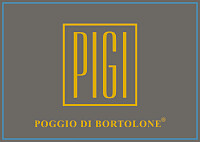
|
|
Sicilia Rosso Pigi 2021 |
|
| Poggio di Bortolone (Sicily, Italy) | |
 Syrah (60%), Cabernet Sauvignon (40%) Syrah (60%), Cabernet Sauvignon (40%) | |
| Price: € 20.00 | Score: |
 Intense ruby red and nuances of garnet red, little transparency. Intense ruby red and nuances of garnet red, little transparency. Intense, clean, pleasing and refined, starts with hints of black
currant, plum and black cherry followed by aromas of violet, blueberry,
blackberry, chocolate, tobacco, mace, vanilla and menthol. Intense, clean, pleasing and refined, starts with hints of black
currant, plum and black cherry followed by aromas of violet, blueberry,
blackberry, chocolate, tobacco, mace, vanilla and menthol.
 Properly tannic attack and however balanced by alcohol, good body,
intense flavors, agreeable. Properly tannic attack and however balanced by alcohol, good body,
intense flavors, agreeable.
 Persistent finish with flavors of black currant, plum and black cherry. Persistent finish with flavors of black currant, plum and black cherry. 18 months in steel tanks, 9 months in cask. 18 months in steel tanks, 9 months in cask. |
|
 Broiled meat and barbecue, Stewed meat with mushrooms, Roasted meat, Cheese Broiled meat and barbecue, Stewed meat with mushrooms, Roasted meat, Cheese |
|

|
|
Cerasuolo di Vittoria Classico Il Para Para 2020 |
|
| Poggio di Bortolone (Sicily, Italy) | |
 Nero d'Avola (60%), Frappato (40%) Nero d'Avola (60%), Frappato (40%) | |
| Price: € 20.00 | Score: |
 Intense ruby red and nuances of garnet red, little transparency. Intense ruby red and nuances of garnet red, little transparency. Intense, clean, pleasing, refined and elegant, starts with hints of
plum, blackberry and black cherry followed by aromas of dried violet, dried
rose, blueberry, strawberry, carob, tobacco, black pepper, vanilla and
menthol. Intense, clean, pleasing, refined and elegant, starts with hints of
plum, blackberry and black cherry followed by aromas of dried violet, dried
rose, blueberry, strawberry, carob, tobacco, black pepper, vanilla and
menthol.
 Properly tannic attack and however balanced by alcohol, good body,
intense flavors, agreeable. Properly tannic attack and however balanced by alcohol, good body,
intense flavors, agreeable.
 Persistent finish with flavors of plum, blackberry and black cherry. Persistent finish with flavors of plum, blackberry and black cherry. 18 months in steel tanks, 9 months in cask, 6 months in bottle. 18 months in steel tanks, 9 months in cask, 6 months in bottle. |
|
 Broiled meat and barbecue, Roasted meat, Stewed meat with mushrooms, Cheese Broiled meat and barbecue, Roasted meat, Stewed meat with mushrooms, Cheese |
|
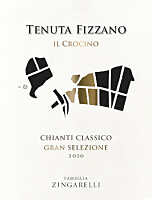
|
|
Chianti Classico Gran Selezione Tenuta Fizzano Il Crocino 2020 |
|
| Rocca delle Macie (Tuscany, Italy) | |
 Sangiovese (90%), Colorino (10%) Sangiovese (90%), Colorino (10%) | |
| Price: € 29.50 | Score: |
 Intense ruby red and nuances of garnet red, little transparency. Intense ruby red and nuances of garnet red, little transparency. Intense, clean, pleasing, refined and elegant, starts with hints of
plum, black cherry and dried violet followed by aromas of dried rose,
blackberry, raspberry, cocoa, licorice, tobacco, leather, mace, vanilla and
menthol. Intense, clean, pleasing, refined and elegant, starts with hints of
plum, black cherry and dried violet followed by aromas of dried rose,
blackberry, raspberry, cocoa, licorice, tobacco, leather, mace, vanilla and
menthol.
 Properly tannic attack and however balanced by alcohol, good body,
intense flavors, agreeable. Properly tannic attack and however balanced by alcohol, good body,
intense flavors, agreeable.
 Persistent finish with flavors of plum, black cherry and blackberry. Persistent finish with flavors of plum, black cherry and blackberry. 20 months in cask, at least 12 months in bottle. 20 months in cask, at least 12 months in bottle. |
|
 Broiled meat and barbecue, Roasted meat, Stewed meat with mushrooms, Hard cheese Broiled meat and barbecue, Roasted meat, Stewed meat with mushrooms, Hard cheese |
|
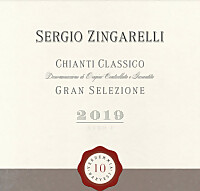
|
|
Chianti Classico Gran Selezione Sergio Zingarelli 2019 |
|
| Rocca delle Macie (Tuscany, Italy) | |
 Sangiovese Sangiovese | |
| Price: € 50.00 | Score: |
 Intense ruby red and nuances of garnet red, little transparency. Intense ruby red and nuances of garnet red, little transparency. Intense, clean, pleasing, refined and elegant, starts with hints of
plum, black cherry and raspberry followed by aromas of dried violet, rose,
blueberry, pomegranate, chocolate, tobacco, cinnamon, mace, licorice,
leather, vanilla and menthol. Intense, clean, pleasing, refined and elegant, starts with hints of
plum, black cherry and raspberry followed by aromas of dried violet, rose,
blueberry, pomegranate, chocolate, tobacco, cinnamon, mace, licorice,
leather, vanilla and menthol.
 Properly tannic attack and however balanced by alcohol, good body,
intense flavors, agreeable. Properly tannic attack and however balanced by alcohol, good body,
intense flavors, agreeable.
 Very persistent finish with long flavors of black cherry, plum and
raspberry. Very persistent finish with long flavors of black cherry, plum and
raspberry.
 16 months in cask, 20 months in bottle. 16 months in cask, 20 months in bottle. |
|
 Broiled meat and barbecue, Roasted meat, Stewed meat with mushrooms, Hard cheese Broiled meat and barbecue, Roasted meat, Stewed meat with mushrooms, Hard cheese |
|
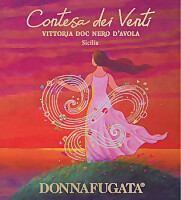
|
|
Vittoria Nero d'Avola Contesa dei Venti 2021 |
|
| Donnafugata (Sicily, Italy) | |
 Nero d'Avola Nero d'Avola | |
| Price: € 17.00 | Score: |
 Brilliant ruby red and nuances of ruby red, little transparency. Brilliant ruby red and nuances of ruby red, little transparency. Intense, clean, pleasing and refined, starts with hints of plum,
blackberry and black cherry followed by aromas of violet, cyclamen,
blueberry, pomegranate, raspberry, juniper and carob. Intense, clean, pleasing and refined, starts with hints of plum,
blackberry and black cherry followed by aromas of violet, cyclamen,
blueberry, pomegranate, raspberry, juniper and carob.
 Properly tannic attack and however balanced by alcohol, good body,
intense flavors, agreeable. Properly tannic attack and however balanced by alcohol, good body,
intense flavors, agreeable.
 Persistent finish with flavors of plum, blackberry and black cherry. Persistent finish with flavors of plum, blackberry and black cherry. 8 months in steel tanks, 9 months in bottle. 8 months in steel tanks, 9 months in bottle. |
|
 Cold cuts, Pasta with meat and mushrooms, Sauteed meat, Mushroom soups, Legume soups Cold cuts, Pasta with meat and mushrooms, Sauteed meat, Mushroom soups, Legume soups |
|
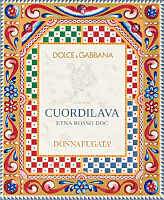
|
|
Etna Rosso Cuordilava Dolce&Gabbana e Donnafugata 2019 |
|
| Donnafugata (Sicily, Italy) | |
 Nerello Mascalese Nerello Mascalese | |
| Price: € 61.00 | Score: |
 Brilliant ruby red and nuances of garnet red, moderate transparency. Brilliant ruby red and nuances of garnet red, moderate transparency. Intense, clean, pleasing, refined and elegant, starts with hints of
cherry, raspberry and strawberry followed by aromas of dried rose,
cyclamen, plum, arbutus berry, red orange, lavender, carob, cinnamon,
graphite, vanilla and menthol. Intense, clean, pleasing, refined and elegant, starts with hints of
cherry, raspberry and strawberry followed by aromas of dried rose,
cyclamen, plum, arbutus berry, red orange, lavender, carob, cinnamon,
graphite, vanilla and menthol.
 Properly tannic attack and however balanced by alcohol, good body,
intense flavors, pleasing crispness. Properly tannic attack and however balanced by alcohol, good body,
intense flavors, pleasing crispness.
 Persistent finish with flavors of cherry, raspberry and strawberry. Persistent finish with flavors of cherry, raspberry and strawberry. At least 24 months in cask. At least 24 months in cask. |
|
 Roasted meat, Stewed meat with mushrooms, Cheese Roasted meat, Stewed meat with mushrooms, Cheese |
|
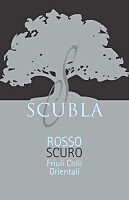
|
|
Friuli Colli Orientali Rosso Scuro 2019 |
|
| Scubla (Friuli-Venezia Giulia, Italy) | |
 Merlot (80%), Refosco dal Peduncolo Rosso (20%) Merlot (80%), Refosco dal Peduncolo Rosso (20%) | |
| Price: € 30.00 | Score: |
 Deep ruby red and nuances of garnet red, little transparency. Deep ruby red and nuances of garnet red, little transparency. Intense, clean, pleasing, refined and elegant, starts with hints of
black currant, black cherry and plum followed by aromas of violet, iris,
blueberry, blackberry, cocoa, tobacco, leather, licorice, vanilla and
eucalyptus. Intense, clean, pleasing, refined and elegant, starts with hints of
black currant, black cherry and plum followed by aromas of violet, iris,
blueberry, blackberry, cocoa, tobacco, leather, licorice, vanilla and
eucalyptus.
 Properly tannic attack and however balanced by alcohol, full body,
intense flavors, agreeable. Properly tannic attack and however balanced by alcohol, full body,
intense flavors, agreeable.
 Persistent finish with flavors of black currant, black cherry and plum. Persistent finish with flavors of black currant, black cherry and plum. 18 months in barrique and cask, 10 months in steel tanks, 3 months in
bottle. 18 months in barrique and cask, 10 months in steel tanks, 3 months in
bottle.
|
|
 Game, Roasted meat, Stewed meat with mushrooms, Hard cheese Game, Roasted meat, Stewed meat with mushrooms, Hard cheese |
|
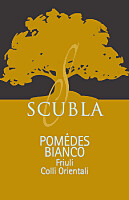
|
|
Friuli Colli Orientali Bianco Pomèdes 2021 |
|
| Scubla (Friuli-Venezia Giulia, Italy) | |
 Pinot Bianco (60%), Friulano (30%), Riesling (10%) Pinot Bianco (60%), Friulano (30%), Riesling (10%) | |
| Price: € 30.00 | Score: |
 Brilliant straw yellow and nuances of straw yellow, very transparent. Brilliant straw yellow and nuances of straw yellow, very transparent. Intense, clean, pleasing, refined and elegant, starts with hints of
apple, apricot and pineapple followed by aromas of hawthorn, broom, citron,
pear, plum, peach, grapefruit, hazelnut, butter, beeswax, almond, vanilla
and mineral. Intense, clean, pleasing, refined and elegant, starts with hints of
apple, apricot and pineapple followed by aromas of hawthorn, broom, citron,
pear, plum, peach, grapefruit, hazelnut, butter, beeswax, almond, vanilla
and mineral.
 Crisp attack and however balanced by alcohol, good body, intense
flavors, agreeable. Crisp attack and however balanced by alcohol, good body, intense
flavors, agreeable.
 Very persistent finish with long flavors of apple, apricot and
pineapple. Very persistent finish with long flavors of apple, apricot and
pineapple.
 Fermented in cask and barrique, 8 months in cask and barrique, 10
months in steel tanks, 3 months in bottle. Fermented in cask and barrique, 8 months in cask and barrique, 10
months in steel tanks, 3 months in bottle.
|
|
 Stuffed pasta with mushrooms and fish, Roasted fish, Roasted white meat, Stewed fish with mushrooms Stuffed pasta with mushrooms and fish, Roasted fish, Roasted white meat, Stewed fish with mushrooms |
|
News |
|
In this section are published news and information about events concerning the world of wine and food. Whoever is interested in publishing this kind of information can send us a mail to our address.
|
AquavitaeReview of Grappa, Distillates and Brandy |
|
|
||||||||||||
Wine Guide ParadeSeptember 2024
|
| |||||||
Privacy Policy | |||||||


| Copyright © 2002-2025 Antonello Biancalana, DiWineTaste - All rights reserved |
| All rights reserved under international copyright conventions. No part of this publication and of this WEB site may be
reproduced or utilized in any form or by any means, electronic or mechanical, without permission in writing from DiWineTaste. |